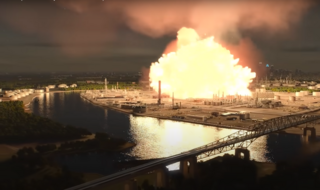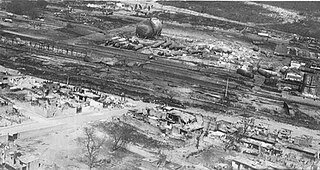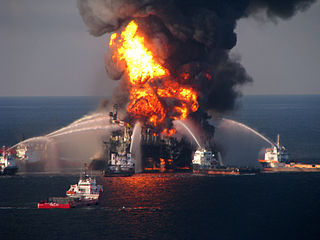
A boiling liquid expanding vapor explosion is an explosion caused by the rupture of a vessel containing a pressurized liquid that is or has reached a temperature sufficiently higher than its boiling point at atmospheric pressure. Because the boiling point of a liquid rises with pressure, the contents of the pressurized vessel can remain a liquid as long as the vessel is intact. If the vessel's integrity is compromised, the loss of pressure drops the boiling point, which can cause the liquid to convert to gas expanding rapidly. BLEVEs are manifestations of explosive boiling.

Liquefied natural gas (LNG) is natural gas (predominantly methane, CH4, with some mixture of ethane, C2H6) that has been cooled to liquid form for ease and safety of non-pressurized storage or transport. It takes up about 1/600th the volume of natural gas in the gaseous state at standard conditions for temperature and pressure.

A natural gas vehicle (NGV) utilizes compressed natural gas (CNG) or liquefied natural gas (LNG) as an alternative fuel source. Distinguished from autogas vehicles fueled by liquefied petroleum gas (LPG), NGVs rely on methane combustion, resulting in cleaner emissions due to the removal of contaminants from the natural gas source.

A gas explosion is the ignition of a mixture of air and flammable gas, typically from a gas leak. In household accidents, the principal explosive gases are those used for heating or cooking purposes such as natural gas, methane, propane, butane. In industrial explosions, many other gases, like hydrogen, as well as evaporated (gaseous) gasoline or ethanol play an important role. Industrial gas explosions can be prevented with the use of intrinsic safety barriers to prevent ignition, or use of alternative energy.
There have been many extremely large explosions, accidental and intentional, caused by modern high explosives, boiling liquid expanding vapour explosions (BLEVEs), older explosives such as gunpowder, volatile petroleum-based fuels such as gasoline, and other chemical reactions. This list contains the largest known examples, sorted by date. An unambiguous ranking in order of severity is not possible; a 1994 study by historian Jay White of 130 large explosions suggested that they need to be ranked by an overall effect of power, quantity, radius, loss of life and property destruction, but concluded that such rankings are difficult to assess.

A series of ten explosions took place on April 22, 1992, in the downtown district of Analco Colonia Atlas in Guadalajara city, Jalisco state, Mexico. Numerous gasoline explosions in the sewer system and fires over four hours destroyed 8 kilometres (5.0 mi) of streets. Gante Street was the most damaged.
Texas Eastern Pipeline (TETCo) is a major natural gas pipeline which brings gas from the Gulf of Mexico coast in Texas and Louisiana up through Mississippi, Arkansas, Tennessee, Missouri, Kentucky, Illinois, Indiana, Ohio, and Pennsylvania to deliver gas in the New York City area. It is one of the largest pipeline systems in the United States. It is owned by Enbridge. Its FERC code is 17.

Cove Point LNG Terminal is an offshore liquid natural gas shipping terminal operated by BHE GT&S, a Berkshire Hathaway Energy company. It is located near Lusby, Maryland, United States, on the western shore of the Chesapeake Bay, and exports liquefied natural gas (LNG) and also stores gas. LNG is exported on specially designed ships known as LNG carriers.
On May 29, 1929, a series of explosions in the sewers of Ottawa, Ontario, Canada, killed one person.

An LNG carrier is a tank ship designed for transporting liquefied natural gas (LNG).

The San Juanico disaster involved a series of fires and explosions at a liquefied petroleum gas (LPG) tank farm in the settlement of San Juan Ixhuatepec, a municipality of Tlalnepantla de Baz, State of Mexico, Mexico, on 19 November 1984. The facility and the settlement, part of Greater Mexico City, were devastated, with 500–600 victims killed, and 5000–7000 suffering severe burns. It is one of the deadliest industrial disasters in world history, and the deadliest industrial accident involving fires and/or explosions from hazardous materials in a process or storage plant since the Oppau explosion in 1921.

Energy resources bring with them great social and economic promise, providing financial growth for communities and energy services for local economies. However, the infrastructure which delivers energy services can break down in an energy accident, sometimes causing considerable damage. Energy fatalities can occur, and with many systems deaths will happen often, even when the systems are working as intended.

AS Alexela is an Estonian company primarily engaged in the energy sector. Alexela's product portfolio includes electricity, natural gas, cylinder gas, tank gas, and automotive fuels. The company employs over 1000 people, and owns more than a hundred gas stations in Estonia.

A gas carrier, gas tanker, LPG carrier, or LPG tanker is a ship designed to transport LPG, LNG, CNG, or liquefied chemical gases in bulk.

The Paramount Hotel explosion occurred on January 28, 1966, in Boston, Massachusetts. A series of explosions under the hotel and resulting fires killed 11 people.











